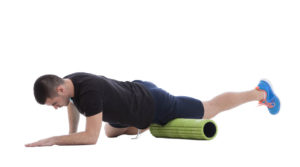Foam rolling went through a phase a few years ago where it seemed to be essential in any warm up. It has now fallen out of favour and isn’t seen as essential to a warm-up anymore. Foam rolling was never essential to any warm-up but I still think there can be a use for it.
I find it useful when used at home if feeling stiff/sore and it makes it easier to ease into larger ranges of movement. My preference is still not to do any foam rolling in a warm-up. This is based primarily because there often isn’t a foam roller about or there isn’t the room.
Does foam rolling actually change tissue?
Along with the idea that you were missing out if you didn’t use it, there was/is a lot of rubbish talked about what it did. Let’s be clear using a foam roller or any other manual therapy, does not break up or realign scar tissue. It does not break up fascial adhesions. It does not warm up the tissue or any other of the less plausible ideas out there.
“The three-dimensional model’s equations revealed that very large forces, outside the normal physiologic range, are required to produce even 1% compression and 1% shear in fascia lata and plantar fascia.”
The quote is from a study in 2008 by Chaudry et al. In simple terms this means that the forces required to remodel tissue are huge. The study calculated that they equate to a couple of tonnes of pressure and all to make a 1% change. That would be sore, very sore!
What are we actually changing?
I stated that we aren’t changing scar tissue or breaking up fascial adhesions but what are we doing when we use a foam roller?
We think and I have to say think that the changes occur because of neurophysiological changes. This is to say that foam rolling affects your nervous system. The pressure that is applied when using the foam roller reduces the tone of the tissue by stimulating the nerves that sense the tension in the muscles. This can even have an effect on areas that you haven’t been working on!
In a study by Aboodara et all 2015 they found that the leg being worked on showed decreased sensitivity to the pressure being applied. They also noted that the leg which had received no treatment also showed a decreased sensitivity. This outcome gives us some indication as to what is happening during soft tissue treatment. For the non-worked leg to have a change like this the changes must be happening elsewhere. The only place this can be is the brain or nervous system more centrally.
How much is enough?
There is no point in rolling back a forward over the same area for long periods of time. You are wasting valuable time if you’re spending minutes on one area. This is time that could be used for actually moving. All it takes is a few seconds to make a difference so there is really no need to spend any length of time on one area. Sullivan et al found as little as 10 seconds made a meaningful change to the range of movement.
How to incorporate it
I am not an advocate of the use of a foam roller in warm ups I’m not totally against it. If you are having a day where you don’t seem to be loosening up then a quick blast to the problem area is a good use of your time. To make this even more effective follow it up with a loaded movement. If you are squatting and your quads aren’t responding to your normal warmup then a quick blast on the roller followed up with a set of squats should see a difference. This allows for the body/mind to recognise the changes that have occurred.
The use of a loaded movement is a very useful method for getting the most of foam rolling. Regardless of if its part of your warm up or if it is some movement drills you are doing at home load the areas up after you’ve done them. At home this could simply be your mobility drills, anything that works the are will do it doesn’t need to be heavy.
Putting it together
- A short bout of foam rolling to the area needing work. 10-20 seconds is enough.
- Use an active movement to better recognise the new range of movement.
- Load the movement up. This can be either bodyweight or external loading.
If you would like to enquire about an appointment or to arrange a phone call then simply click on the link and fill in the short enuiry form.


